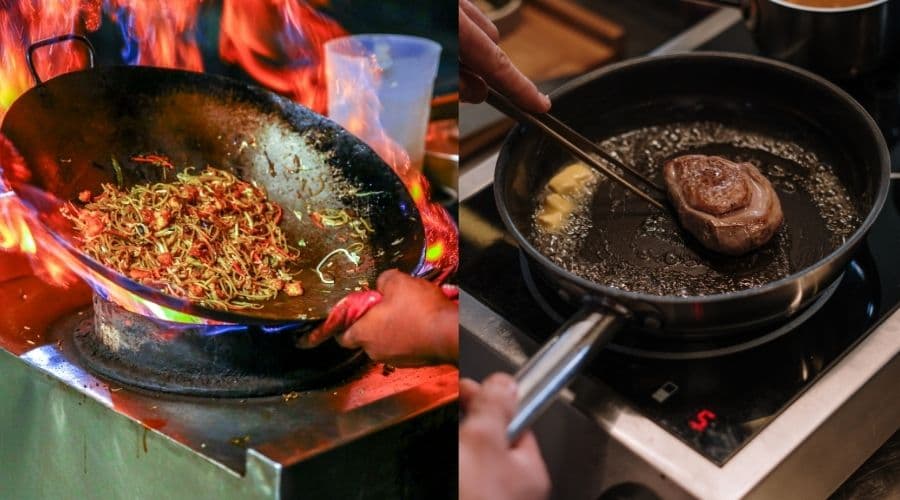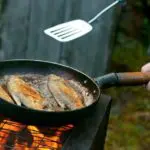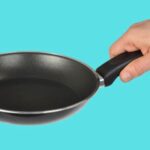Wok vs frying pan – which one is better?

The wok and frying pan are both cooking utensils used for preparing food. They have different shapes and purposes, which leads to different ways of using them.
Woks have become increasingly popular in recent years as an excellent option for home cooks looking for something different and more exciting to cook with. Woks are essentially large, round metal pans with a wide lip that is used to cook food over high heat.
On the other hand frying pans are metal pans with a small, flat bottom. These pans are used to cook food in a medium-heat environment.
Woks and frying pans have different uses, which is why they have their own rights with regards to how they should be treated and cleaned.
What is the difference between a wok and a frying pan?
A wok is a traditional Chinese cooking vessel that is shaped like an inverted V with a flared bottom. It has long handle or two side handles and is used for deep-frying, stir-frying, or braising.
Frying pans are more commonly found in American kitchens. They have shorter handles and are designed to be used over medium-high heat for cooking foods such as eggs, bacon, and pancakes.
What is Wok
A wok is cooking vessel with a rounded bottom and sloping sides, typically made of carbon steel. It is used in many Asian cuisines, both for stir-frying and deep-frying. In general, a wok is much wider at the base than the top, which allows it to be easily rotated while cooking. It is used for stir frying and shallow frying.
Woks are made from cast iron or carbon steel with a nonstick coating, and they can be used on an open flame or electric stovetop as well if it comes with flat bottom.
Uses of wok
When most people think of a wok, they likely envision an Asian cooking vessel. But the wok is actually a versatile tool that can be used in a variety of ways in the home kitchen. Here are six ways to use your wok:
- As a deep-frying pan: The wok’s small size and slanted sides create an efficient surface area that allows for quick and even cooking of foods such as chicken, shrimp, and vegetables without overheating the food.
- As a steamer: The wok’s small size makes it perfect for steaming and boiling vegetables and grains. Steaming also ensures you’ll only need one pot to cook your food, rather than transferring the food from a large pot to the wok on the stovetop.
- As an oven roaster: The thinly designed sides of a wok create an even heat distribution that helps cook poultry, meat, and vegetables evenly without adding extra oil or fat. Simply preheat your oven to 350 degrees Fahrenheit before adding your ingredients, then roast until done.
- As an oil-less sauté pan: The wok’s slanted sides allow for a large surface area, making it ideal for cooking with oil-free methods.
What is frying pan
Frying pans are the most common cooking appliance in the home, and for good reason. They are versatile and efficient – perfect for cooking up eggs, bacon, or a quick stir-fry. The best frying pans are made from either stainless steel or non-stick coated steel.
Stainless steel can withstand high heat, and is one of the most common materials used for cooking.
As compared to woks, frying pans are very simple and easy to use. They come in a variety of sizes and shapes, but the most common are round or square.
Wok vs frying pan?
There are pros and cons to each cooking method, so it’s important to know what these are before making a decision. Here are the key points to consider when comparing woks and frying pans:
Wok vs Frying Pan: Size
When it comes to cooking, size really does matter. A wok, for example, is larger than a frying pan and is better suited for cooking larger quantities of food. This is because a wok’s circular shape gives it more surface area to cook with. Additionally, its ridges help stir-fry food quickly and evenly.
Frying pan is smaller in size and is better for cooking smaller quantities of food. This is because a frying pan’s shape creates more contact between the food and the heat source especially when using wok on or induction stove electric, which means that the food cooks faster.
Wok vs Frying Pan: Shape
Woks have a more curved shape than frying pans, which makes them better for stir-frying. Their concave design evenly distributes heat, making it easy to prevent food from sticking and creating evenly cooked dishes.
Frying pan on the other hand has a more straight shape. It is used to fry food which is harder to stir-fry since non stick pan can be used without any oil or fat. Therefore, it is better for cooking eggs, meat and fish.
Wok vs Frying Pan: Material
Woks are usually made of carbon steel or cast iron and are very durable. Frying pans are made of glass or stainless steel, non stick or any kind of material.
Wok vs Frying Pan: Capacity
The capacity of woks is larger than that of frying pans. Woks are often thought of as being larger capacity than frying pans. This is because a wok can hold up to three times the amount of food as a frying pan. Woks are also generally deeper, meaning they can cook thicker pieces of food more evenly. Frying pans, on the other hand, are typically smaller in size and are better suited for shallow-frying or poaching.
Wok vs Frying Pan: Heat distribution
Frying pans are notorious for distributing heat unevenly, making it difficult to cook food evenly. This is because frying pans have a design that prevents the fat from spreading out evenly.
Woks, on the other hand, distribute heat more evenly because they have ridges that create channels in which the oil can circulate. This means that foods cooked in a wok will be less prone to sticking and will come out with a crispy exterior.
Woks are often recommended as a better option for cooking than frying pans because they distribute heat more evenly. This is due to the design of the wok, that allows for more even heating.
Wok vs Frying Pan: Performance
Woks are often seen as the superior cooking vessel because they produce more consistent heat than frying pans. This means that your food will cook evenly and quickly, resulting in perfectly cooked ingredients every time. Additionally, a wok can be used to cook meat or vegetables in a relatively short amount of time.
However, woks are more difficult to use than frying pans. They require a lot of practice to become proficient with them, so if you’re new to cooking, it might be best to start with a frying pan instead.
Pros of Wok
Woks are versatile cooking utensils that can be used for a variety of dishes. They are easy to use and provide quick and delicious meals. Here are some of the benefits of using a wok:
- They cook food quickly and evenly, making them ideal for stir-fries and other quick dishes.
- They’re also great for cooking with large quantities of vegetables or meats, as they can easily accommodate large batches.
- They’re a great way to cook rice, noodles or other grains.
- Finally, woks are a fun way to cook—they produce plenty of scent and sound while they cook, making them perfect for entertaining guests.
- They’re also great for a variety of dishes, as they provide an opportunity to experiment with a variety of flavors and ingredients.
- To clean a wok, simply use regular dish soap and hot water.
Conclusion
Which is better for cooking – a wok or a frying pan? The answer to this question depends on your personal preferences.
In general, frying pans are easier to use and better for making bacon, fragile things like fish and eggs where the oil is evenly distributed. Woks, on the other hand, are more versatile and better for stir-frying and deep frying because they create more intense heat.
They’re also great for making rice and other Asian dishes because they can cook food in a shorter amount of time.
Ultimately, it depends on what you’re looking to cook and how you plan to do it.




